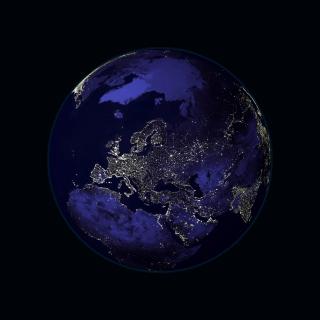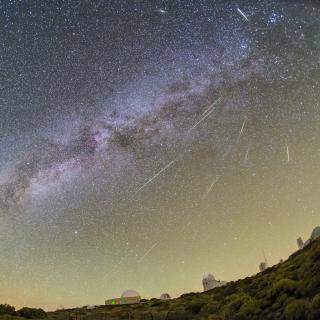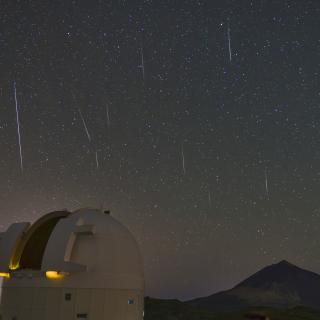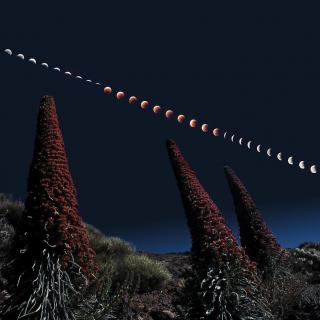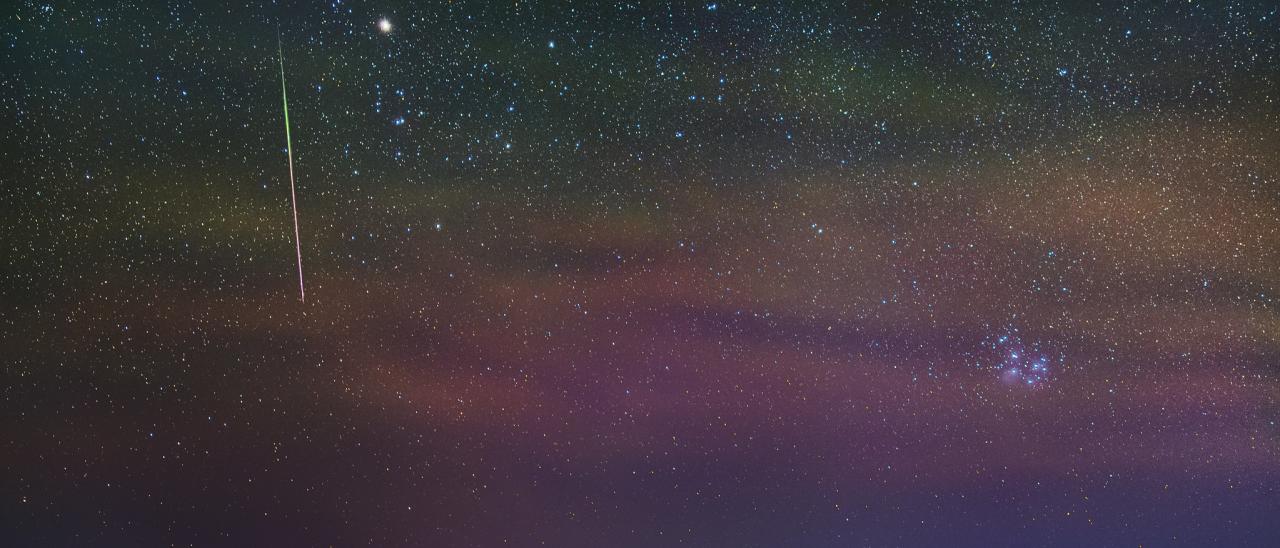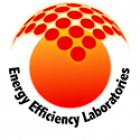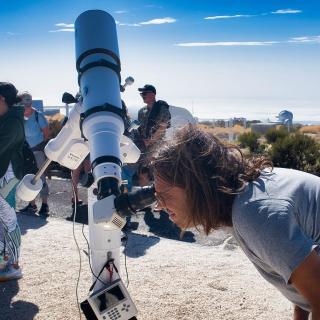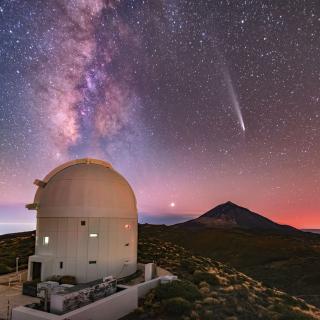Bright and colourful Geminid over the volcano of La Palma in the early morning of 12 December 2021. In the sky, green and red airglow. At the top of the image we can see the star Aldebaran (alpha Tauri) and the Hyades star cluster; and on the right the Pleiades star cluster. Credit: Juan Carlos Casado (starryearth). High resolution image: https://flic.kr/p/2n9GdW4
During the nights of 13th and 14th of December we will enjoy the peak of the Geminid meteor shower. This event will be broadcast live from the Canary Islands Observatories via the sky-live.tv channel, with the collaboration with the Energy Efficiency Labs, and from Extremadura, thanks to Extremadura Buenas Noches project.
For more than 10 years, Geminids have been the most intense meteor shower of the year, exceeding 100 meteors per hour (ZHR), followed by the Perseids and the Quadrantids. However, on the night of 13-14 December, the Moon will be 72% illuminated, making it difficult to see the faintest meteors.
For the year 2022, we will be able to see Geminids from 19 November to 24 December. Although, as every year, their maximum activity will take place in mid-December. The maximum is expected at 13:00 UT on 14 December, so the nights of 12-13 and 13-14 December will be the best moments to observe this meteor shower.
Geminids meteor shower, one of the most attractive for many researchers, was first observed in 1862.
How to observe the Geminids 2020
The meteors appear to be coming from a point, the radiant, in the constellation of Gemini (hence the Geminids), which is near the well known constellation of Orion. It is most practical to fix one’s view on one area of the sky and keep it there for at least a few minutes in order to detect a Geminid. It may be best to lie on the ground, suitably protected and, above all, you need to be patient.
Geminids can be observed from both hemispheres. Even though the activity is greater in the northern hemisphere than in the south, because the radiant is higher above the horizon, quite a lot of the Geminids can still be observed in southern skies.
Remnants of the asteroid (3200) Phaethon
So called “shooting star” are really tiny dust particles of different sizes (between fractions of millimetres and centimetres in diameter) which are left behind by comets, (or occasionally asteroids) during their orbits round the sun, due to the evaporation produced by the Sun’s heat. The resulting cloud of particles (termed meteoroids) are dispersed along the orbit of the comet, and is crossed each year by the Earth in its orbit round the Sun. During this encounter the meteoroids are heated by friction when they enter the Earth’s atmosphere at high velocity. They evaporate completely or partially, giving rise to the well know brilliant trails or “shooting stars”, which are scientifically termed meteors. Those meteors which survive the atmospheric friction impact on the surface of the Earth and are then called meteorites.
Normally the originators of these meteor showers are comets, but in the case of the Geminids, not so. A small asteroid (3200) Phaethon, is the supposed originator of the Geminids, an idea postulated in 1983, which is still a puzzle for the astronomers. The team led by Dave Jewitt (UCLA), using NASA’s STEREO space probe, our eyes on the Sun to “hunt” asteroids and comets as they approached it, realised in 2010 that (3200) Phaethon was showing a growth in its brightness. This was something new, which they called a “rocky comet”. Is it a hybrid between an asteroid and a comet? To summarize, this is a curious asteroid which gets so close to the Sun, every 1.4 years, similar to the approach of a comet, that the Sun’s heat “burns off” the residual layers of dust which cover its rocky surface, which forms a “dusty tail”.
"The expectations for this year's Geminids are good with activity rates similar to other years. This year the best time to observe the Geminids will be in the early evening as the Moon will be low on the eastern horizon. In a dark place we may be able to detect about one Geminid every 3-4 minutes. The slowness of these meteors makes it easier to see them," says Miquel Serra-Ricart (IAC).
Live from Canary Island Observatories and Extremadura
Among the outreach initiatives of the European project EELabs (eelabs.eu) the sky-live.tv channel will broadcast the meteor shower live from the Teide Observatory (Tenerife) and from Roque de los Muchachos Observatory (La Palma), with the collaboration of Tourism Area of La Palma Government, the Sociedad de Promoción y Desarrollo Económico de La Palma (SODEPAL), via the Programa de Promoción de AstroTurismo, y and the MAGIC and LST-1 (Cherenkov Telescope Array) telescopes. In addition, this date with the Geminids will also be broadcast from Extremadura, as part of the Extremadura Buenas Noches project. The date will be next Monday, 13th December at 22:30 UT-local time /23:30 CET.
Link: https://sky-live.tv/
EELabs (eelabs.eu) is a project funded by the program INTERREG V-A MAC 2014-2020, co-financed by FEDER (European Fund for Regional Development) of the European Union, under contract MAC2/4.6d/238. 5 centres in Maraconesia (IAC, ITER, ULPGC, SPEA-Azores, SPEA-Madeira) work in EELabs. The objective of EELabs is to create Laboratories to measure the energy efficiency of the artificial night-time lighting in natural protected areas of Maraconesia (the Canaries, Maderia, and Azores).
Three supercomputing centres: The el Centro Extremeño de Tecnologías Avanzadas (CETA-CIEMAT), the Consorci de Serveis Universitaris de Catalunya (CSUC) and the Instituto de Astrofísica de Canarias (IAC) are collaborating in the distribution of the broadcast on the web portal (sky-live.tv).
Audiovisual material
- High resolution images and videos Geminids: https://flic.kr/s/aHsmKwTM67
- Wavy trajectory of a Geminid: https://flic.kr/p/2n9JWwg
- High resolution meteor showers: https://flic.kr/s/aHsjH2BFa4
- Travel in a comet: https://youtu.be/iCoqxLjMmmU
- Simulation orbit Geminids: https://www.meteorshowers.org/view/Geminids
- Activity of the Geminids 2020: imo.net/members/imo_live_shower?shower=GEM&year=2020
